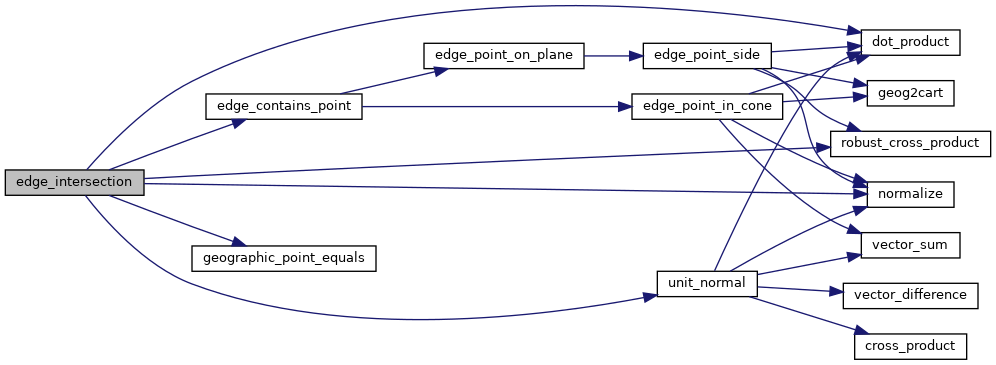◆ edge_intersection()
| int edge_intersection | ( | const GEOGRAPHIC_EDGE * | e1, |
| const GEOGRAPHIC_EDGE * | e2, | ||
| GEOGRAPHIC_POINT * | g | ||
| ) |
Returns true if an intersection can be calculated, and places it in *g.
Returns false otherwise.
Definition at line 1131 of file lwgeodetic.c.
1134 LWDEBUGF(4, "e1 start(%.20g %.20g) end(%.20g %.20g)", e1->start.lat, e1->start.lon, e1->end.lat, e1->end.lon);
1135 LWDEBUGF(4, "e2 start(%.20g %.20g) end(%.20g %.20g)", e2->start.lat, e2->start.lon, e2->end.lat, e2->end.lon);
1137 LWDEBUGF(4, "e1 start(%.20g %.20g) end(%.20g %.20g)", rad2deg(e1->start.lon), rad2deg(e1->start.lat), rad2deg(e1->end.lon), rad2deg(e1->end.lat));
1138 LWDEBUGF(4, "e2 start(%.20g %.20g) end(%.20g %.20g)", rad2deg(e2->start.lon), rad2deg(e2->start.lat), rad2deg(e2->end.lon), rad2deg(e2->end.lat));
void robust_cross_product(const GEOGRAPHIC_POINT *p, const GEOGRAPHIC_POINT *q, POINT3D *a)
Computes the cross product of two vectors using their lat, lng representations.
Definition: lwgeodetic.c:634
void unit_normal(const POINT3D *P1, const POINT3D *P2, POINT3D *normal)
Calculates the unit normal to two vectors, trying to avoid problems with over-narrow or over-wide cas...
Definition: lwgeodetic.c:541
static double dot_product(const POINT3D *p1, const POINT3D *p2)
Convert cartesian coordinates on unit sphere to lon/lat coordinates static void cart2ll(const POINT3D...
Definition: lwgeodetic.c:446
int edge_contains_point(const GEOGRAPHIC_EDGE *e, const GEOGRAPHIC_POINT *p)
Returns true if the point p is on the minor edge defined by the end points of e.
Definition: lwgeodetic.c:1038
int geographic_point_equals(const GEOGRAPHIC_POINT *g1, const GEOGRAPHIC_POINT *g2)
Definition: lwgeodetic.c:170
Definition: liblwgeom.h:401
References dot_product(), edge_contains_point(), GEOGRAPHIC_EDGE::end, FP_EQUALS, geographic_point_equals(), GEOGRAPHIC_POINT::lat, GEOGRAPHIC_POINT::lon, LW_FALSE, LW_TRUE, LWDEBUG, LWDEBUGF, normalize(), rad2deg, robust_cross_product(), GEOGRAPHIC_EDGE::start, unit_normal(), POINT3D::x, POINT3D::y, and POINT3D::z.
Referenced by circ_tree_distance_tree_internal(), and test_edge_intersection().
Here is the call graph for this function:

Here is the caller graph for this function:
